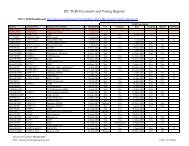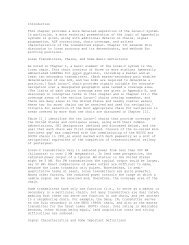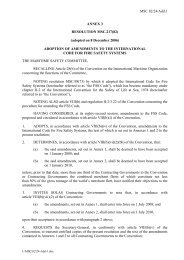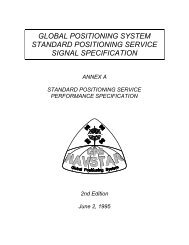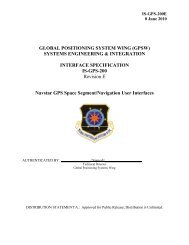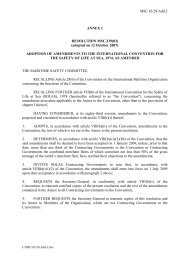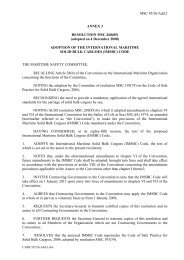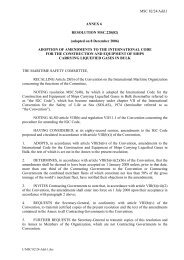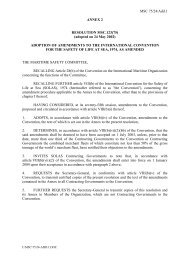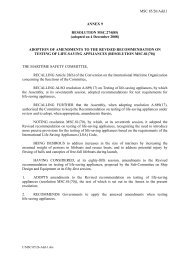IS-GPS-800A - US Coast Guard Navigation Center
IS-GPS-800A - US Coast Guard Navigation Center
IS-GPS-800A - US Coast Guard Navigation Center
You also want an ePaper? Increase the reach of your titles
YUMPU automatically turns print PDFs into web optimized ePapers that Google loves.
3.3 Signal ModulationThe signals modulated on the L1 RF carrier include C/A, P(Y), M, and L1C, which consists of two components:L1C P and L1C D . The modulation used is binary offset carrier (BOC) as described in reference document [2]. Themodulation is essentially shaped BPSK where a subcarrier is used to shape the spectrum.The bitstream of the L1C P signal is constructed by modulo-2 addition of L1C P -code and L1C O -code. The overlaycode, L1C O , is described in section 3.2.2.1.2. The PRN ranging codes, L1C P and L1C D , are described in section3.2.2.1.1. The bitstream of L1C D is constructed by modulo-2 addition of L1C D -code and the L1C message symboltrain, D L1C (t). The timing relationship of L1C signal components is described in Figure 3.3-1.The bitstream of the L1C D signal is modulated on L1 carrier frequency using BOC (1, 1) modulation, with asubcarrier frequency of 1.023 MHz and a chipping rate of 1.023 Mbps. Each bit of the bitstream is applied to aBOC (1,1) spreading symbol consisting of one cycle of a 1.023 MHz squarewave, defined as binary 10 (1= positivebinary bit value, see Figure 3.3-2a) with total duration 1/1.023 microseconds. The BOC (1,1) spreading symbols aredefined using sine-phasing, so they are aligned with the bits of the L1C D -code. Contrary to convention, a “0” is inphasewith the carrier and a “1” is 180 degrees out of phase with the carrier.The bitstream of the L1C P signal is modulated on L1 carrier frequency using TMBOC modulation technique. TheL1C P TMBOC technique uses a mixture of BOC (1, 1) spreading symbols and BOC (6,1) spreading symbols, whereeach BOC (6,1) spreading symbol consists of 6 cycles of a 6 x 1.023 MHz squarewave, defined as binary101010101010 (1= binary bit value), with total duration 1/1.023 microseconds (see Figure 3.3-2b).The pattern of BOC (1,1) and BOC (6,1) spreading symbols repeats every 10230 spreading symbols correspondingto a new bit of L1C O -code. Let the index of the spreading symbols for L1C P be t = 0, 1, . . ., 10229, where t = 0 isthe first spreading symbol in the next bit of L1C O -code. Write t as t = u t + 33 v t , where u t = 0, . . ., 32 and v t = 0, . . .,309. Then all spreading symbols in L1C P are BOC (1,1), except for those that are BOC (6,1) that occur for those twith u t = 0, 4, 6, and 29 (i.e, t = 0, 4, 6, 29, 33, 37, 39, 62, …, 10197, 10201, 10203, 10226). This pattern is shownin Figure 3.3-2c.The BOC (1,1) and BOC (6,1) spreading symbols are defined using sine-phasing, so they are aligned with the bits ofL1C P -code. The phase relationship between L1C D and L1C P is defined in section 3.2.1.6.25 <strong>IS</strong>-<strong>GPS</strong>-<strong>800A</strong>8 June 2010




